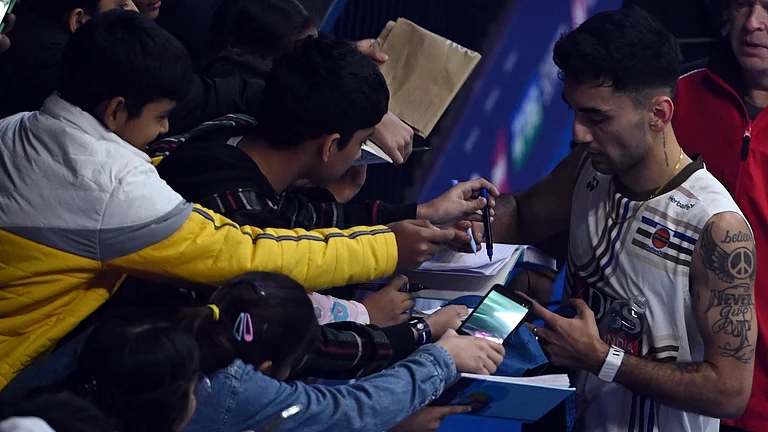It is the late 15th century. Vasco da Gama’s discovery of a sea route to India for a possible spice trade brings with it a new life for Portugal. In a parallel track, Krishnadevaraya, the Vijayanagara monarch, ushers in a golden era of cultural advancement. Author Vasudhendra’s novel Tejo Tungabhadra, recently translated from the Kannada into English by Maithreyi Karnoor, is a magnificent tale of two landmarks in world history, which treats cultures and religions as human sentiments that define eras.
Literary translator Uma Shirodkar interviewed the author for Outlook. Some excerpts.
How did you navigate the politics of emotion that plays such a pivotal role in your novel?
Basic human emotions like love, pain, pride and hunger are the same everywhere and form the basic building blocks with which to assemble stories. The politics of emotion has always existed, irrespective of time and space. Vasco da Gama’s maritime adventures were a success story for the Portuguese and other Europeans. But it spelt doom for the protagonists of my novel, the Jewish Bella and the Christian Gabriel, who had to sacrifice their love.
I talk about diverse religions in my novel: Hinduism, Islam, Judaism and Christianity. My characters are not good or kind humans due to the religion they practice; they also turn bitter because of the same religion.
The novel is set in a time hardly explored in Indian historical fiction. What inspired you to pick this particular period?
Vijayanagara of 1492–1518 was a golden era, according to historians. But from a commoner’s perspective, this seems highly unlikely. It is implausible that people would have prospered under a king who was always at war with neighbouring states.
Documenting history from the perspective of the elite will result in recurring portrayal of modern India as a prosperous era. However,
ordinary citizens know that this is far from reality. Saints and poets from the Vijayanagara era, including Kumaravyasa, talk about poverty, starvation, suffering and corruption in government.
My initial idea was of a historical fiction set in Vijayanagara from a commoner’s perspective, but I was fascinated by my research on the parallel Portuguese period. Iberian maritime success was much celebrated by historians and brought untold wealth for its monarchs. Unfortunately, this also brought suffering to its commoners, especially in the form of anti-Semitic violence. While exploring the gamut of emotions, I ended up with this 460-page novel, with its two halves dedicated to the two eras.
Tejo Tungabhadra spans two different and tumultuous periods in world history. How did you connect these two planes?
A bird’s eye view of history only glorifies kings, queens, nobility and their religious and socio-political exploits. But when we zoom in, an entirely different scenario emerges. For example, we come to know that king Krishnadevaraya wanted to rename a Shaiva village with a Vaishnava name against public sentiments, solely to satisfy his ego. Even the famous poet and jester Tenali Ramakrishna had to change his original Shaiva name of ‘Ramalinga’ to ‘Ramakrishna’ to get royal patronage from Krishnadevaraya, a Vaishnava.
Reading about anti-Semitic violence in Portugal made me immediately connect it with the atrocities that Dalits and minorities face in India today. A period in history is not divorced from the other and can be analysed from a contemporary lens. I believe there is no concrete genre like historical fiction because we write contemporary fiction only in a different time and space. In my opinion, merely narrating a historical tale without a contemporary mindset won’t help at all.

During the periods I chose, Vijayanagara and Lisbon saw a lot of political and economic relations, well-documented by historians and travellers. I thus chose a love story between a Lisbon man and a Vijayanagara woman. There are no boundaries in love. All stories are seamlessly connected.
How did you go about bringing cohesiveness between the diverse themes and characters?
I researched the subject for three years. I focused mainly on the social lives of Vijayanagara and Lisbon. Since I couldn’t find much material about the Portuguese sailor’s life at sea, I studied a research book on the lifestyles of medieval Spanish sailors, which seemed not very different from that of the Portuguese.
There was not much literature I could find in India documenting the commoner’s life in the era. Epics like the Ramayana and Mahabharata are landmark works. But poets and authors in the past mostly wrote about mythology and royalty. It was considered rather offensive to write about anything else. Consequently, at least in Kannada and Sanskrit, this did not allow much literature about the common man until the late 18th and the early 19th centuries. That is why I consider the epics to be both a boon and a curse.
Foreign travellers were keen observers of our people. They documented their observations as travelogues without which we would not have had much knowledge about our ancestors. Interestingly, I had never visited Portugal let alone meeting a Portuguese before writing my novel. Now my readers vouch that I have depicted life in medieval Lisbon more authentically than Vijayanagara. Perhaps, that is the power of imagination.
How do the parallels compare with each other with respect to the themes of caste discrimination, gender inequality and religious violence?
In my novel, we see all kinds of discrimination faced by people from both periods. A Dalit fisherman abducted by Vasco Da Gama from Calicut is forcibly converted to Christianity in Lisbon. However, he is more at ease leading a life of poverty in a foreign land in the absence of caste discrimination, instead of in the ‘golden era’ of Calicut.
Gender discrimination is a major theme. The lives of women and transwomen have been portrayed in great detail. Transwomen had better lives than those of other Indian women. Numerous Hindu women were brainwashed by religious fundamentalists, submitting themselves to the barbaric practice of sati. Is it any different from the religious fundamentalism that exists today?
A Christian character is tolerant of his Christian brethren but justifies and rationalises violence against Islam. Even in such times, I see some bright moments when people surpass religious barriers for humanity’s sake. For example, Alfonso Albuquerque was the first ruler to ban sati in India, although he was infamous for his tyrannical rule. Hence, I believe that only such actions are real historical milestones.





















